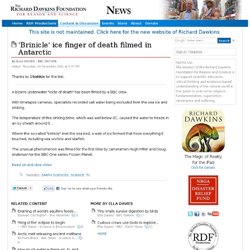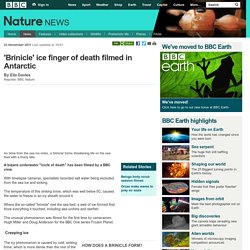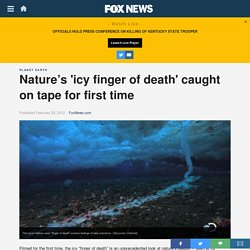Zoom
Trash

Ice finger of death. 'Brinicle' ice finger of death filmed in Antarctic - Ella Davies - BBC Nature. Draining of world's aquifers feeds...

Damian Carrington - The Observer "In the long run, I would still be more concerned about the impact of climate change, but this work shows that even if we stabilise the climate, we might still get sea level rise due to how we use water. " 'Ring of fire' eclipse to begin - - BBC News - Science & Environment An "annular eclipse" will be visible from a 240 to 300km-wide swathe of Earth stretching from Asia across the Pacific to the western US on Monday. Arctic melt releasing ancient methane Richard Black - BBC News - Science &... Scientists have identified thousands of sites in the Arctic where methane that has been stored for many millennia is bubbling into the atmosphere.
No Love for Comet Wipeout Sid Perkins - Science - AAAS.org Did a comet wipe out woolly mammoths and an ancient Indian culture almost 13,000 years ago? Search results for brinicle. BBC Nature - Frozen Planet's brinicle sequence explained. 28 December 2011Last updated at 02:36 BBC Natural History Unit producer Kathryn Jeffs reveals the extreme conditions her film-making crew had to endure to capture the bizarre "ice finger of death" - known as a brinicle - under the ice in Antarctica.

Research All shoots begin with research, and inspiration comes from many places… scientific papers, discussions with scientists, images from books or the internet. Often it is difficult to pin down the details you need to set up a shoot, especially when locations are remote, and you do not get more remote than below the ice of McMurdo Sound, Antarctica. We were lucky to be able to draw on the phenomenal experience of the Antarctic dive legends Rob Robbins and Steve Rupp, who helped pin down a focused "wish-list" of stories I hoped to film. On that list, but with very little expectation of filming them, were some bizarre, beautiful ice formations they called "brinicles".
Planning the shoot We really wanted to capture that scene. On location. BBC: Frozen Planet, 'Brinicle' ice finger of death - vidaru.com. BBC Nature - 'Brinicle' ice finger of death filmed in Antarctic. 23 November 2011Last updated at 10:01 By Ella Davies Reporter, BBC Nature As brine from the sea ice sinks, a 'brinicle' forms threatening life on the sea floor with a frosty fate.

A bizarre underwater "icicle of death" has been filmed by a BBC crew. With timelapse cameras, specialists recorded salt water being excluded from the sea ice and sinking. The temperature of this sinking brine, which was well below 0C, caused the water to freeze in an icy sheath around it. Nature’s 'icy finger of death' caught on tape for first time. The never-before-seen "finger of death" evokes feelings of awe and terror.

(Discovery Channel) Filmed for the first time, the icy “finger of death” is an unprecedented look at nature’s beauty -- seen at its devastating worst. Called a brinicle (or brine icicle), cameramen Hugh Miller and Doug Anderson used a time-lapse camera to capture this awe-inspiring event beneath the Antarctic ice shelf for the upcoming Discovery Channel special series, Frozen Planet. “We were just blown away by how beautiful they were,” producer Kathryn Jeffs told FoxNews.com. Jeffs was in Antarctica with Miller and Anderson to capture the unique event. It was pretty emotional when we saw that we got it. - Kathryn Jeffs, "Frozen Planet" producer This magnificent yet terrifying phenomenon is caused by brine, or naturally occurring salt water, which tends to be denser than the surrounding seawater and has a lower freezing point.
The area also happened to be a seal habitat, notoriously territorial creatures. Ice Stalactite. Ice stalactite. Finger of doom facts. “30 Rock” Meets Icy Finger of Death – Dean's Corner. Swimming Beneath the Brinicles, in Antarctica. Diver Rory Welsh swimming by a 2m long Brinicle in McMurdo Sound, Antarctica.

(Image Credit: Andrew Thurber, Oregon State University) Incipient brinicles viewed from below. The coloration is from algae that live in the matrix of the ice above. (Image Credit: Andrew Thurber, Oregon State University) At Little Razor Back Island, Antarctica, this 3m deep area is home to thousands of brinicles that often extend to the seafloor. Living amongst them are thousands of amphipods that can be seen swimming in this image. While normally only close to the ice, when disturbed the amphipods swarm, much like a nest of bees. The open end of a brinicle, where cold, dense fluid emerges into the seawater. Diver Rory Welsh swimming by a 2m long Brinicle in McMurdo Sound, Antarctica. It’s rare these days to uncover a phenomenon completely new to science, one that expands the world’s catalog of objects in strange and wondrous ways.
Brinicles can be understood in a conceptually similar way. Dr. Brinicle (ice finger of death) Watch starfish flee an icy finger of death. Gixibyte.tumblr. Brinicles are an Icy Finger of Death That Kills the Ocean Floor. Midwestern lore has it that icicles hanging off roofs can go right through a man unlucky to pass underneath as it falls.

However, such terrestrial dangers seem like small potatoes when compared with “brinicles,” the icy sheaths of super cold water found in polar regions. These bizarre, twisting tendrils of ice snake down from the much colder surface and freeze everything they touch once they hit bottom. Now, a BBC camera crew has successfully captured a time-lapse film of the birth of a brinicle, and the death it brings to the ocean floor. Unlike icicles, which are formed by water dripping and freezing in colder air, brinicles form because of the peculiarities of super cold ocean water.
In the arctic, the air can be -4° F, while the water is comparatively warmer at 29° F. Eventually, the tube touches bottom and the freezing touch extends outward, killing anything in its path. (via BBC Nature, image via Doug Anderson) Relevant to your interests.